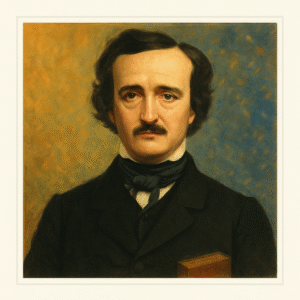 Edgar Allan Poe (1809–1849) lived a short, restless life that produced an outsize share of American literature’s unforgettable images—the tolling raven, the beating heart, the pestilential masquerade. Yet his most enduring structural innovation may be quieter: he invented the modern detective story and sketched, almost in one gesture, the genre’s toolkit.
Edgar Allan Poe (1809–1849) lived a short, restless life that produced an outsize share of American literature’s unforgettable images—the tolling raven, the beating heart, the pestilential masquerade. Yet his most enduring structural innovation may be quieter: he invented the modern detective story and sketched, almost in one gesture, the genre’s toolkit.
Born in Boston and orphaned young, Poe was taken in by the Richmond merchant John Allan, from whom he took his middle name and a lifetime of complicated dependence. After an early brush with the University of Virginia and a brief stint at West Point, he turned fully to letters: editing magazines, writing criticism with a razor’s edge, and producing poetry and tales that could actually sell in the bustling magazine economy of the 1830s and 1840s. The finances were always precarious; the method never was. Poe thought of fiction as an “effect” engineered by design, and nowhere was his engineering clearer than in his “tales of ratiocination.”
In April 1841, “The Murders in the Rue Morgue” introduced C. Auguste Dupin, a brilliant, eccentric Parisian who solves a pair of grotesque killings by pure analysis—what Poe called ratiocination. In three stories—“Rue Morgue,” “The Mystery of Marie Rogêt” (1842–43), and “The Purloined Letter” (1844)—Poe effectively lays down the DNA of detective fiction. Dupin arrives with a companion-narrator who marvels at the detective’s method; there is a baffled police force; there are misleading clues and an eventual analytical dénouement delivered in the detective’s own voice. Even the setting matters: the modern city as a labyrinth of facts, noise, and misdirection.
Each story also pioneers a particular subgenre. “Rue Morgue” is the prototypical locked-room mystery, complete with a solution both shocking and, in retrospect, inevitable. “Marie Rogêt” is a remarkable exercise in armchair detection, using newspaper reports of a real Manhattan murder (the Mary Rogers case) to show how a reasoner might sift rumor from data. “The Purloined Letter” gives us the foundational “hiding in plain sight” plot and, along the way, dramatizes a truth detectives still rely on: to catch a mind, you must think with it.
Poe’s fascination with codes, ciphers, psychology, and misdirection bleeds into related works such as “The Gold-Bug,” which helped popularize cryptanalysis for general readers, and essays exploring how people think badly under pressure. These preoccupations—pattern recognition, motivated error, the elegant reveal—are now the furniture of detective fiction.
It is no accident that Arthur Conan Doyle openly acknowledged his debt, modeling Sherlock Holmes and Watson on Dupin and his narrator, then extending Poe’s logic into a Victorian science of clues. From Doyle to Christie to the police procedural and the prestige TV detective, one can trace a straight line through Poe’s compact inventions: the eccentric genius, the admiring sidekick, the staged explanation, the city as puzzle-box.
Poe’s personal life remained turbulent—his marriage to his young cousin Virginia Clemm ended with her death in 1847; his own death in Baltimore two years later was sudden and mysterious. But the literary legacy is crisp. He didn’t merely write a few detective tales; he built the template. Mystery writers have been working—happily—inside his blueprint ever since.